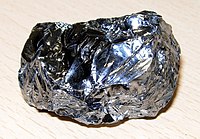
Photo from wikipedia
Abstract Due to the mobility of Zn atoms, it is challenging to prepare single-phase Zn4Sb3 samples. Here, several bulk Zn4Sb3 samples were prepared by vacuum melting, quenching, and spark plasma… Click to show full abstract
Abstract Due to the mobility of Zn atoms, it is challenging to prepare single-phase Zn4Sb3 samples. Here, several bulk Zn4Sb3 samples were prepared by vacuum melting, quenching, and spark plasma sintering. The effects of different sintering molds on the density, homogeneity, and thermoelectric performance of Zn4Sb3 were investigated. The samples sintered using a graphite mold are rich in Zn on the lower surface and poor in Zn on the upper surface. This segregation is due to the migration of Zn atoms driven by the electric current during sintering. Besides, metallic Zn is easily enriched in the holes of low-density samples, and sintered using graphite molds is insufficient to eliminate the holes. The samples sintered using a steel mold have a uniform composition and are nearly entirely dense. This is because the steel mold's resistivity is much lower than that of the Zn4Sb3 sample, and the electric current mainly flows through the steel mold. A dense bulk Zn4Sb3 sample’s ZT up to 1.3 at 425 °C can be obtained using a steel mold.
Journal Title: Journal of Alloys and Compounds
Year Published: 2021
Link to full text (if available)
Share on Social Media: Sign Up to like & get
recommendations!